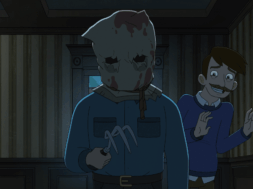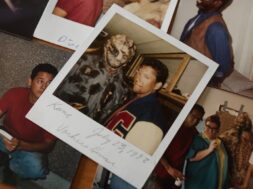If there’s one thing slasher movies have taught us, it’s this: the killer is never dead. Especially if the killer happens to be Jason Voorhees.
No matter how hard many final girls have tried, Jason Voorhees keeps popping back up to prowl Crystal Lake anew. Except, Friday the 13th: The Final Chapter threatened to put him in the ground for good. Releasing as the Golden Age of Slashers drew to a close, The Final Chapter saw Voorhees slain by a young Tommy Jarvis (Corey Feldman). Friday the 13th: A New Beginning, released 35 years ago on March 22, 1985, marked a pivotal crossroads for the franchise. The second entry in what would become known as the “Tommy Jarvis trilogy” marked a strange outlier, offering a sleazy whodunnit that attempted to change the trajectory of the series.
Set a few years after the events of the previous film, A New Beginning marks, well, a new beginning for Tommy Jarvis (now played by John Shepherd). In the time between films, poor Tommy suffered mental breakdowns resulting in stints at psychiatric hospitals. Released into a halfway home for at-risk teens, Tommy’s struggles with assimilating back into society become complicated when Jason Voorhees seems to resurface to begin killing those around him.
Except, much to the chagrin of fans, Voorhees remains dead throughout this entry.
In A New Beginning, a heavy emphasis is placed on Tommy’s unstable mental state. He’s withdrawn and intense, breaks into a sweat quickly, and suffers nightmarish visions of Jason Voorhees. Like the closing moments of Tommy in the previous film, Tommy’s current mindset is meant to present him as an unreliable protagonist. A grisly ax murder of a fellow at-risk teen, Joey, sparks a new wave of killings. It could be a triggering point for any of the unstable inhabitants of the halfway home, or the wacky and bitter redneck family neighbors, but it could just as likely be Tommy. The default, of course, is that Jason Voorhees is the killer, but the masks become a dead giveaway to the copycat killer. Flashbacks and hallucinations show the real Jason’s mask, with red detailing, and the copycat wears a knockoff mask with blue chevrons.
The killer? Paramedic driver and father of the murdered Joey, Roy Burns (Dick Wieand).
It’s not just that this sequel attempts to shake things up by featuring a whole different killer in a new setting that makes it such a weird outlier in the canon, it’s also director and co-writer Danny Steinmann‘s tonal and aesthetic approach to the whodunnit. For one, A New Beginning marks an oddly musical entry. Nearly every character is singing or dancing at some point, including the film’s most jovial kill: Miguel A. Núñez Jr.‘s Demon is caught with his pants down, slaughtered in an outhouse while cooing “Ooh, baby” to his already dead girlfriend outside. Goth Violet (Tiffany Helm) receives a machete to her torso while dancing her heart out to Pseudo Echo’s “His Eyes.”
Steinmann originally planned to give Violet a much more disturbing end, with machete going straight into her crotch. Realizing the scrutiny this kill would receive with the MPAA, the kill was toned down. It would’ve made for a sleazy death in a film that already feels sleazy. The MPAA might have had a severe aversion to gore and violence, but they seemed to have zero qualms about the nudity. Granted, nudity is pretty common in ’80s slashers, but Steinmann appears to use it to overcompensate for the edited gore. Considering his career up to that point had been in porn and exploitation cinema, well, he approached the sex and nudity scenes much the same way.
According to Peter Bracke’s book Crystal Lake Memories: The Complete History of Friday the 13th, production for this film was notoriously troubled with hardcore drug use, likely fanning the flames of the movie’s weirdness. The central protagonist is a sweaty mute, allowing Pam (Melanie Kinnaman) and Reggie (Shavar Ross) to handle the heavy living in battling faux-Jason. Outside of these three, you’ve got a slew of bizarre slapstick characters like Ethel (Carol Locatell) and her son Junior (Ron Sloan), the unbalanced teens of the halfway home, and a few randoms in the area that all are behaving as though they’re in an entirely different movie than a slasher. For a whodunnit, none of these characters serve as plausible red herrings. The idea was likely that most would buy into a Jason Voorhees resurrection, or that Tommy was the new Voorhees, but it’s still a strange tonal clash.
At a time when interest in the slasher had waned dramatically, and when the franchise was receiving criticisms for being repetitive, A New Beginning was meant to shake things up. What if someone else took up the masked killer mantle? What if it took place somewhere other than summer camp? It went about as well as it did when Halloween III: Season of the Witch decided to test the waters by removing Michael Myers. The immediate sequel, Jason Lives, course-corrected and put it all in the subtitle; Jason Voorhees returned from the grave.
A New Beginning depicts a fork in the road that was immediately closed in the follow-up. It’s sleazy, oh so quirky, and a wholly unique outlier in the franchise. That means it tends to be one of the most polarizing and divisive entries in the series. You’re on board with this brand of chaos, or you’re severely annoyed by poor, broken Roy Burns’ attempt to copycat an icon.
Even thirty-five years later, it’s a film that still sparks debate among fans.













